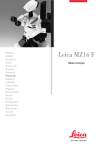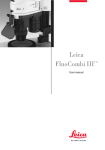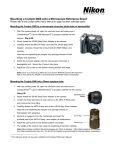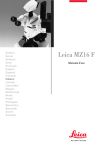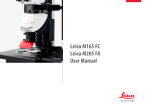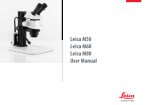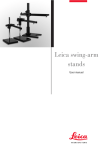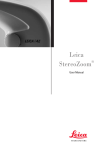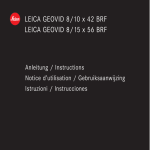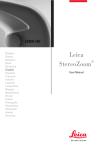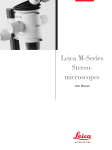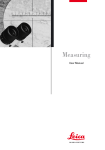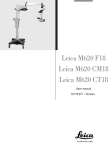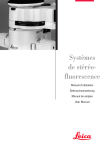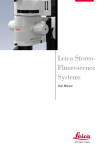Download Leica MZ16 F - Pdfstream.manualsonline.com
Transcript
Leica MZ16 F User manual Dear User, We thank you for your faith in our product, and hope it brings you both enjoyment and success. With the new fully apochromatic Leica MZ16 F from Leica Microsystems, you have purchased the best-performing, manual fluorescence stereomicroscope on the market. The Leica MZ16 F and its motorized counterpart, the Leica MZ16 FA, provide the greatest zoom (16:1), the highest resolution (up to 840 Lp/mm), the highest magnification (115× with standard optics), the largest numerical aperture (0.14), a patented illumination and filter system for the most intense fluorescence, and the innovative HL RCTM high-performance transmitted-light base for excellent contrast. The entire imaging system, including the 16:1 zoom, objective and ErgoTube® is apochromatically corrected using with much technological effort. Contrast, sharpness, richness in detail, resolution, image and color fidelity are optimum. In addition, the patented illumination beam path guarantees at every zoom level that light utilization is at a maximum and that fluorescence images are intensely luminous on a jet black background. 2Leica MZ16 F – User manual In developing our instruments, we place great value on simple, self-explanatory operation. However, please take the time to read the user manual and the operating safety information so that you can become familiar with the advantages and features of your Leica MZ16 F high-performance stereomicroscope, so that you can use it optimally and safely. Should you ever have any questions, please consult your local Leica representative. You will find the address of your nearest local representative, as well as valuable information about Leica Microsystems products and services, from Leica Microsystems on our web site at www.leica-microsystems.com. We are gladly at your service. Customer service is a big thing with us. Not only before the sale, but afterwards as well. Leica Microsystems (Switzerland) Ltd. Stereo & Macroscope Systems www.stereomicroscopy.com Leica MZ16 F – User manual2 Operating controls 10 9 8 7 6 4 5 1 3 2 Fig. 1 Leica MZ16 F with trinocular video/phototube and Leica digital camera 1 2 3 4 5 6 Zoom magnification changer Coarse/fine focusing drive Double iris diaphragm Rapid filter changer for four selectable filter sets Filter holder for an individually selectable filter Switch for activating/deactivating the UV shutter 3 7 Trinocular video/phototube 8 Adjustable tubes for adjusting the interpupillary distance from 52mm–76mm 9 Knurled rings for adjusting the diopter settings from +5 to –5 10 Adjustable and attachable eyecups Leica MZ16 F – User manual Contents Page 1. Safety concept . . . . . . . . . . . . . . . . . . . . . . . . . .5 1.1 The user manual . . . . . . . . . . . . . . . . . . . . . . . . .5 1.1.1 Diagrams . . . . . . . . . . . . . . . . . . . . . . . . . . .5 1.1.2 Symbols used . . . . . . . . . . . . . . . . . . . . . .6 1.2 Safety instructions . . . . . . . . . . . . . . . . . . . . . . .6 1.3 Light source . . . . . . . . . . . . . . . . . . . . . . . . . . . . .9 2. Overview of the instrument . . . . . . . . . . . . . .10 3. Assembly . . . . . . . . . . . . . . . . . . . . . . . . . . . . . .12 3.1 Assembly sequence . . . . . . . . . . . . . . . . . . . .12 3.1.1 Expansion diagram . . . . . . . . . . . . . . . . .13 3.2 Assembly of stereomicroscope with stand . .14 3.3 Additional components . . . . . . . . . . . . . . . . . .15 3.3.1 Video/phototube . . . . . . . . . . . . . . . . . . .15 3.4 Light source . . . . . . . . . . . . . . . . . . . . . . . . . . . .15 3.4.1 Lamp housing 106 z . . . . . . . . . . . . . . . . .15 3.4.2 Supply units . . . . . . . . . . . . . . . . . . . . . . .15 Page 4. Operation . . . . . . . . . . . . . . . . . . . . . . . . . . . . . .18 4.1 Description . . . . . . . . . . . . . . . . . . . . . . . . . . . . 18 4.1.1 Fluorescence technology . . . . . . . . . . .18 4.1.2 Functional principle . . . . . . . . . . . . . . . .18 5. Functions . . . . . . . . . . . . . . . . . . . . . . . . . . . . . .18 5.1 Stereomicroscope settings and adjustments . . . . . . . . . . . . . . . . . . . . . . . .18 5.1.1 Observation without fluorescence . . . .19 5.1.2 Double iris diaphragm . . . . . . . . . . . . . .19 5.2 Commissioning the fluorescence system . .20 5.3 Rapid filter changer . . . . . . . . . . . . . . . . . . . . .20 6. Work flow . . . . . . . . . . . . . . . . . . . . . . . . . . . . .21 7. 7.1 7.2 7.3 7.4 Appendix . . . . . . . . . . . . . . . . . . . . . . . . . . . . . .22 Filter sets . . . . . . . . . . . . . . . . . . . . . . . . . . . . . .22 Technical data . . . . . . . . . . . . . . . . . . . . . . . . .23 Optical data . . . . . . . . . . . . . . . . . . . . . . . . . . .27 Dimensions . . . . . . . . . . . . . . . . . . . . . . . . . . . .28 3.5 UV protection screen . . . . . . . . . . . . . . . . . . . .16 3.6 Equipping the filter changer . . . . . . . . . . . . . .16 3.6.1 Filter sets for fluorescence . . . . . . . . . .16 3.6.2 Simple filter holders . . . . . . . . . . . . . . . .17 3.6.3 Inserting the filter . . . . . . . . . . . . . . . . . .17 3.6.4 Slot for filter slide . . . . . . . . . . . . . . . . . .17 4 Leica MZ16 F – User manual 1. Safety concept 1.1 The user manual Included with your Leica MZ16 F fluorescence stereomicroscope is an interactive CD-ROM with all pertinent user instructions in German, English, French, Spanish, Italian, Portuguese, Dutch, Danish, Swedish, Finnish and Greek. Keep it in a safe place, and readily accessible to the user. User manuals and updates are also available for you to download and print from our web site at www.stereomicroscopy.com. The Leica MZ16 F is the manual fluorescence stereomicroscope of the Leica M stereomicroscope series. This operating manual describes the special functions of the Leica MZ16 F and important instructions for its operational safety, maintenance, and accessories. Like all instruments of the Leica M stereomicroscope series, the Leica MZ16 F consists of modules, which allow an almost unlimited variety of custom equipment configurations. The identical modules, such as stands, binocular tubes, accessories, etc. are described in User Manual M2-105-0 for Leica M stereomicroscopes, which also contains additional safety instructions pertaining to the stereomicroscope, accessories and electrical accessories, as well as care instructions. Before installing, operating or using the instruments, read the user manuals listed above. In particular, please follow all safety instructions. To maintain the unit in its original condition and to ensure safe operation, the user must follow the instructions and warnings contained in these user manuals. 1.1.1 Diagrams (1.2) Numbers in parentheses within the descriptions refer to diagrams and the items in these diagrams. Example (1.2): Figure 1 is located on page 3, and item 2 is the focusing drive. Special manuals are provided for a number of accessories: – User Manual M2-216-1 for lamp housing with high-pressure mercury burner. – User Manual for ebq 100 isolated supply unit for 100W high-pressure mercury burners. – User Manual M2-267-1 for the motorized focus system. – User Manual M2-166-2 for FluoCombi IIITM Leica MZ16 F – Safety User manual concept 5 1.1.2 Symbols used 1.2 Safety instructions Description Warning of a danger This symbol indicates especially important information that, if not observed, – can cause hazards to personnel, – can lead to functional disturbances and damaged instruments. Warning of hazardous electrical voltage This symbol indicates especially important information that, if not observed, – can cause hazards to personnel, – can lead to functional disturbances and damaged instruments. Danger due to hot surface This symbol warns against touching hot surfaces, e.g. those of light bulbs. Important information This symbol indicates additional information or explanations that intend to provide clarity. Action 왘 This symbol refers to actions described in the The Leica MZ16 F is a manual fluorescence stereomicroscope with 16:1 zoom for fluorescence applications. The optics system consists of two observation beam paths, a patented TripleBeam® third beam path specifically for fluorescence illumination and the patented FLUOIII® filter system. The entire imaging system, including the 16:1 zoom, objective and ErgoTube® is apochromatically corrected. The Leica MZ16 F consists of these modules: – Stereomicroscope – Stand, binocular tube, objective, eyepieces and (if applicable) accessories for photography, etc. – Power supply – Filter sets with barrier and excitation filters on one filter holder – Three simple filter holders for transmitted light observation and protection from UV light – Filter holder for individual filters – UV protection screen – 106 z lamp housing with 50W or 100W highpressure mercury burner with stray-light protection – Supply unit text that are to be carried out. Additional notes • This symbol indicates additional notes and explanations provided in the text. 6 Leica MZ16 F – Safety concept Permitted uses Place of use With the Leica MZ16 F fluorescence stereomicroscope, entire fluorescent specimens can be examined three-dimensionally and unprepared, manipulated, sorted and documented. The separate beam path for the fluorescence illumination in the Leica MZ16 F as well as the very bright high-pressure mercury burner and specially selected filter sets enable you to distinguish the finest structures and enhance the quantity of information for incident light fluorescence. Special filter holders also enable observation without fluorescence in transmitted light or incident light. – The Leica MZ16 F may only be operated in a closed, dust-free room, which is free of oil vapors and other chemical vapors, as well as extreme humidity, and within a temperature range of +10 to +40. – Electrical components must be assembled at least 10 cm away from the wall and from flammable substances. – Large temperature fluctuations, direct sunlight and vibrations should be avoided. These conditions can distort measurements and micrographic images. – Stereomicroscopes in warm and warm-damp climatic zones require special care in order to prevent the build up of fungus. Non-intended use If the Leica MZ16 F, its components and accessories are used other than as described in the user manual, injury or property damage may occur. Never: – install other plugs or cables. – change, rebuild or take apart parts, if not specifically instructed to in this manual. – allow unauthorized persons to open parts. – use the MZ16 F for examining, or operating on the human eye. The devices and accessories described in this User manual have been tested for safety and potential hazards. The responsible Leica affiliate or the main plant in Wetzlar must be consulted whenever the device is altered, modified or used in conjunction with non-Leica components that are outside of the scope of this manual. Unauthorized alterations to the device or noncompliant use shall void all rights to any warranty claims! Leica MZ16 F – Safety User manual concept Responsibilities of the person(s) in charge of instrument Ensure that – the Leica MZ16 F and accessories are operated, maintained and repaired only by authorized and trained personnel. – the operating personnel has read, understands, and is observing these instructions as well as those listed on page 5, and, in particular, the safety instructions. Transport – Use the original packaging for shipping or transporting the stereomicroscope and its accessory components. – In order to prevent damage from vibrations, disassemble all moving parts that (according to the user manual) can be assembled by the customer and pack them separately. These include the objective, binocular tube, eyepieces, lamp housing, burner in the 106 z lamp housing, etc. 7 Repairs and servicing – Only Leica Microsystems-trained service technicians, or technical specialists assigned by the person in charge of the instrument, are permitted to carry out repairs. – Only original Leica Microsystems spare parts may be used. – Disconnect the power cable before opening voltage-carrying parts such as the power supply or the supply unit. Touching the live circuit can cause injury. Installation in third-party products When installing Leica products into third-party products, note the following: The manufacturer of the complete system or its dealer is responsible for following all applicable safety instructions, laws and guidelines. Health risks Workplaces with stereomicroscopes both improve and make visual tasks easier, but they also place high demands on the human visual apparatus and the muscular "holding apparatus" of the user. Depending on the duration of uninterrupted work, asthenopia and musculoskeletal problems may occur. For this reason, appropriate measures for reduction of the workload must be taken: – optimal arrangement of workplace, work assignments and work flow (changing tasks frequently). – thorough training of the personnel, giving consideration to ergonomic and organization aspects. The ergonomic design and construction of Leica M series stereomicroscopes are intended to reduce the exertion of the user to a minimum. Disposal – The product must be disposed of in accordance with locally applicable laws and regulations. – Dispose of used high-pressure mercury burners as hazardous waste. Legal requirements Direct contact with eyepieces is a potential transmission method for bacterial and viral infections of the eye. The risk can be kept to a minimum by using personal eyepieces for each individual or detachable eyecups. Adhere to general and local regulations relating to accident prevention and environmental protection. Conformity with European Community directive The Leica MZ16 F and its accessories are constructed in accordance with the latest technologies and are provided with a statement of conformity with EC requirements. 8 Leica MZ16 F – Safety concept 1.3 Light source: safety instructions Precautions by the manufacturer Lamp housing – UV protection screen in front of the specimen plane prevents the user from looking directly into the UV rays. – Simple filter holders (that have only two openings for the observation beam paths) in the available positions of the rapid filter changer prevent direct UV radiation from reaching the eyes. – UV shutter (which can be activated/deactivated) prevents direct UV radiation from reaching the eyes. – UV filters in the observation beam path protect the eyes. – The stray-light protection on the lamp housing prevents irradiation of the hands. The Leica MZ16 F may be used only together with the Leica 106 z lamp housing for the 100W or 50W mercury burner, supply unit and stray-light protection. Warning UV radiation can harm the eyes. Therefore: – Never look into the light spot on the specimen plane without a UV protection screen. – Always fill all of the filter positions with filter holders. – Fill empty filter positions with the simple filter holders (which have only two openings for the observation beam paths). – Do not select a white, strongly reflective background for the stage. – Never open the lamp housing while the lamp is switched on. Risk of explosion, UV exposure, blinding! Leica Microsystems accepts no liability for damages resulting from the use of lamp housings from other manufacturers. – Never open the lamp housing while the lamp is switched on. Unplug the supply unit from the power supply: Risk of explosion, UV exposure, blinding! – Before opening the lamp housing, allow it to cool off for at least 15 minutes. Danger of explosion, danger of burns. – Never cover the air duct on the lamp housing. Danger of fire! – Use the stray-light protection. Danger to eyes from UV radiation. Supply unit Always unplug the supply unit from the power supply: – when installing and disassembling the lamp housing – before opening the lamp housing – when replacing the high-pressure mercury burner and other parts, such as the heatabsorbing filter or the collector – during maintenance work on the supply unit. Leica MZ16 F – Safety concept 9 2. Overview of the instrument 6 12 5 4 2 3 9 10 13 11 1 Fig. 2 Left side of the Leica MZ16 F with ErgoTube® from the user’s perspective 1 Stand (transmitted or incident light stand with corresponding illumination). Pictured here is the HL RC™ transmitted-light base for best relief contrast. 2 Focusing drive: (pictured) manual coarse/fine drive with column (see User Manual M1-105-0) or motorized focus system (see User Manual M2-267-1) 3 Microscope carrier or FluoCombi™ (changer for one planapochromatic and one HR microscope objective) 10 4 The Leica MZ16 F optics carrier with two observation beam paths and a TripleBeam® third beam path, motorized FLUOIII® filter system and adapter for 106 z lamp housing 5 ErgoTube® with variable viewing angle of 10° to 50° (pictured) or trinocular tube (in Figure 3.5) 6 Wide-field eyepieces for persons wearing glasses Leica MZ16 F – Overview of the instrument 6 12 5 8 7 4 3 2 10 9 13 11 1 Fig. 3 Right side of the Leica MZ16 F from the user’s perspective with trinocular tube, video objective and Leica DFC300 FX digital camera for fluorescence 7 Filter sets: the scope of delivery includes three simple filter holders (which have only two openings for the observation beam paths) for empty filter positions and transmitted or incident light observation without fluorescence. Additionally, various filter sets of your choice for fluorescence (excitation and barrier filter on one filter holder) are available. Leica MZ16 F – Overview of the instrument 8 Filter holder for an individually selectable filter, such as a gray filter 9 Interchangeable objective planachromatic or planapochromatic 10 UV protection screen with arm 11 Gliding stage (optional) 12 Leica 106 z lamp housing for 50W or 100W mercury burner with stray-light protection (not pictured) 13 Supply unit for lamp housing 106 z 11 3. Assembly Basic components such as the stand, column, microscope carrier, binocular tubes and optical accessories are, thanks to their modular design, identical for all Leica M series stereomicroscopes. Therefore, for assembly instructions, please refer to the User Manual for Leica M stereomicroscopes, M2-105-0. The assembly of the UV aperture protection is described in this User Manual. The lamp housing, supply unit and adjustment of the high-pressure mercury burner are described in User Manual M2-216-1. 3.1 Assembly sequence The microscope components are best assembled in this order: – Stand: base and column with focusing drive (manual or motorized) and focusing stop (for motorized focus and FluoCombi III™) – Microscope carrier or FluoCombi III™ – Leica MZ16 F optics carrier – Binocular or trinocular tube – Eyepieces and eyecups – Stage plate or special stage (gliding stage, heating stage) – Objective – UV protection screen with arm – Lamps: high-pressure mercury burner in lamp housing; for the HL RC™ transmitted-light stand, fiber-optic light guide with light source – Supply unit for lamp housing – Electrical connections (for motorized focus and illuminators) – Equipment of filter changer – Equipment of the filter insert with an individual filter, where applicable Either the integrated clamping screws or an Allen key is necessary for assembly; these are included in delivery. 12 Leica MZ16 F – Assembly 10 447 160 10 445 301 10 445 302 10 445 303 3.1.1 Expansion diagram 106z 11 504 066 11 504 069 10 446 229 10 445 822 HD F 10 446 308 ICA 10 446 237 HD V 10 446 309 10 446 238 HD-50 10 446 197 10 446 271 10 446 260 RS 232 10 447 080 10 446 182 MZ16 F 10 447 064 MZ16 FA 10 447 063 10 447 157 10 447 051 10 447 050 10 446 157 10 445 819 10 447 101 10 447 075 Plan/Planapo Motor focus 10 446 176 / 10 447 041 10 446 227 Filter Sets 10 447 220 10 447 221 10 447 217 10 447 222 10 447 218 10 447 223 10 447 219 10 447 224 10 447 225 10 447 226 10 447 227 10 447 215 10 447 216 Leica MATS 10 447 165 FluoCombi IIITM 10 447 324 10 446 301 Leica MATS 10 447 164 10 447 106 / 10 447 185 10 445 631 10 445 363 10 445 387 10 445 367 HL 10 446 359 HL-RCTM Leica MZ16 F – Assembly 13 Microscope carrier ➔ focusing drive 왘 Fasten the microscope carrier (4.3) to the Leica MZ16 F according to User Manual M2-105-0 on the focusing drive (4.2). Tool: Allen key. 3.2 Assembly of stereomicroscope with stand Do not yet connect the peripherals to the power supply! Or, if available: Focusing drive ➔ stand base 왘 Fasten the FluoCombi III™ to the focusing drive 왘 Fasten the manual or motorized focusing drive (4.2) as described in User Manual M2-166-2. Tool: Allen key. (4.2) to the column according to User Manual M2-105-0 (manual) or M2-267-1 (motorized) on the base (4.1). Tool: Allen key. 왘 For motorized focus and FluoCombi III™, fasten the focusing stop to the stand column under the focusing drive using a clamping screw. Optics carrier ➔ microscope carrier The Leica MZ16 F optics carrier and the FLUOIII® filter system make up a single unit, which is factory-adjusted. They may not be taken apart. 왘 Insert the Leica MZ16 F optics carrier (4.4) When using the motorized focus, be certain to read the corresponding User Manual M2 -267-1, in particular the safety instructions. according to User Manual M2-105-0 into the microscope carrier (4.3) or into the FluoCombi III™ and fasten it using a clamping screw. 6 8 5 4 2 3 9 7 1 1 2 3 4 5 6 7 8 9 Base Focusing drive Microscope carrier Optics carrier Video/photo tube Eyepiece Objective Lamp housing 106 z Supply unit Fig. 4 Right side of the Leica MZ16 F 14 Leica MZ16 F – Assembly 3.3 Additional components 3.4 Light source 왘 Fasten the other components and other individ- The Leica 106 z lamp housing is the light source for the Leica MZ16 FA and is used with 100W or 50W mercury lamps, corresponding supply units and stray-light protection. ual accessories according to User Manual M2-105-0: – Insert the binocular tube (2.5) or the video/ phototube into the dovetail ring on the FLUOIII® filter system and fasten it using a clamping screw. – Insert the eyepieces (4.6) in the tubes and fasten them using the clamping screws. – If necessary, place soft eyecups for preventing eye infections over the built-in eyecups (see User Manual M2-105-0). – Screw the objective (4.7) into the bottom of the optics carrier (4.4) counterclockwise. Please read – the separate User Manual M2-216-1 for the Leica lamp housing – the user manual and safety instructions for the ebq 100 supply unit – the user manual and safety instructions provided by the lamp manufacturer, and, in particular, the section on how to proceed if a lamp breaks and releases mercury. 3.3.1 Video/photo tube We recommend using the trinocular video/phototube (4.5) or the HD-V video/phototube with 100% light in the video/photo output, in order to achieve shorter exposure times at low fluorescence levels. 왘 Insert the video/photo tube (4.5) into the ring connector on the FLUOIII® filter system according to User Manual M2-105-0 and fasten it using the clamping screw. 왘 Fasten a binocular tube to the HD-V video/photo tube using a clamping screw. Do not switch on the supply unit until you have read and familiarized yourself with the functions of the Leica MZ16 F, provided in the "Operation" chapter. After it is switched on, the burner must be adjusted immediately. 3.4.1 Lamp housing 106 z Fasten the 106 z lamp housing (4.8) to the adapter part as described in User Manual M2-216-1. 3.4.2 Supply units The supply unit for 50W mercury lamps is described in User Manual M2-216-1. The 100W mercury lamps are powered by the ebq 100 (4.9) supply unit. Please read the separate instruction manual provided by the manufacturer. Leica MZ16 F – Assembly 15 3.5 UV protection screen ➔ microscope carrier 3.6 Equipping the filter changer 왘 Fasten the UV protection screen (5.1) using a The patented FLUOIII® filter system consists of a filter changer for barrier and excitation filters, a UV shutter that can be activated/deactivated, and a filter insert for a filter holder with your choice of filter. hexagon-head screw (5.3) to the left or right side of the microscope carrier. Tool: Allen key. Always position the UV protection screen so that the operator can never look directly at the light spot (see page 9): 왘 Set the UV protection screen (5.1) laterally using the arm (5.2). 왘 Loosen the hexagon-head screw (5.3). 왘 Move the UV protection screen up or down The filter changer can hold a total of four filter sets. The filter sets for fluorescence are labeled (see page 22). All filter sets are equipped with a transponder for automatic filter detection and can also be used with the motorized Leica MZ16 FA. The scope of delivery of the Leica MZ16 F includes three filter holders without fluorescence for empty filter positions and transmitted or incident light observation without fluorescence. These filter holders have two empty openings for the observation beam paths. The third opening to the illumination beam path is closed. using the arm. 왘 Tighten the hexagon-head screw (5.3). If you are using fewer than four filter holders with fluorescence filters, always insert the included simple filter holders with closed illumination beam path into the available positions. Otherwise, there is a risk of danger to the eyes from direct UV radiation from the third beam path. Also, they protect the system from dust. 3.6.1 Filter sets for fluorescence 3 2 1 Fig. 5 UV protection screen 1 UV protection screen 2 Arm 3 Hexagon-head screw 16 The filter sets for fluorescence contain, on one filter holder, two barrier filters to the visual beam paths and one excitation filter to the illumination beam path. The fluorescence filters have a transponder with the specific filter data for use with the motorized Leica MZ16 FA. The filter sets are labeled (see page 22). Leica Leica MZ16 MZ16 F –FUser – Assembly manual 3.6.2 Simple filter holders 3.6.3 Inserting the filter Three simple filter holders are included in the scope of delivery of the Leica MZ16 F. These filter holders have two empty openings for the observation beam paths. The third opening, to the illumination beam path, is closed. Use these filter holders When inserting the filter sets, avoid touching the filters if at all possible in order to avoid fingerprints. If you touch them, clean the filters using a soft, lint-free cloth and pure alcohol. – if you want to work briefly (no more than 15 seconds) without fluorescence illumination. To avoid overheating the filter holder, do not use the filter holder to block the mercury light for more than 15 seconds. – If you want to block the mercury light for longer than that, activate the UV shutter (see page 19). – if you want to change to transmitted light or incident light observation without fluorescence. – at all times in empty filter changer positions, in order to protect yourself from UV radiation and protect the system from dust. 왘 Insert the filter holder (6.1) into the filter changer such that the label (e.g. GFP1) is upright and legible on the right side of the slide slot. • Ensure that the contour of the filter holder matches the contour of the microscope. 왘 Rotate the filter changer by hand until it latches into place. • If the filter holder has not been inserted correctly, the filter changer does not rotate. Insert a total of four filter holders. 3.6.4 Slot for filter slide There is a slot (6.2) in the filter changer system for an individually selectable filter, for example a gray filter. If you are using fewer than four filter holders with fluorescence filters, always insert the included simple filter holders with closed illumination beam path into the available positions. Otherwise, there is a risk of danger to the eyes from direct UV radiation from the third beam path. 2 1 Fig. 6 Filter changer, equipped with filter holders 1 Filter changer with filter sets 2 Filter slide for filter holder with individual filters Leica MZ16 F – Assembly User manual 17 4. Operation 5. Functions 4.1 Description 5.1 Stereomicroscope settings and adjustments 4.1.1 Fluorescence technology Fluorescent substances light up (fluoresce) when irradiated with short-wave excitation light. Fluorescence technology makes use of this property by coloring or marking certain object structures and details that do not have their own fluorescence with a fluorescent dye. One such dye is green fluorescent protein (GFP), which is used in molecular biology. 4.1.2 Functional principle With the Leica MZ16 F fluorescence stereomicroscope, entire fluorescent specimens can be examined three-dimensionally and unprepared, manipulated, sorted and documented. With a fully apochromatic optics system, manual 16:1 zoom and built-in double iris aperture, the Leica MZ16 F is the high-performance stereomicroscope for fluorescence applications. The patented, separate TripleBeam® light path* for fluorescence illumination and the patented FLUOIII® filter system* provide highest-quality fluorescence images. The very bright high-pressure mercury burner and specially selected filter sets enable you to distinguish the finest structures and enhance the quantity of information for incident light fluorescence. We recommend that you first familiarize yourself with the controls of the Leica MZ16 F in transmitted light without the presence of fluorescence illumination. After switching on the high-pressure mercury lamp, you need to adjust the burner immediately see User Manual M2-216-1). Familiarize yourself with the functional elements of the Leica MZ16 F such as the binocular tube, eyepieces, zoom magnification changer, focusing drive, stands etc. by referring to User Manual M2-105-0 for Leica M stereomicroscopes. This manual describes all settings of the stereomicroscope in detail. The following describes only the functions that are specific to the Leica MZ16 F with fluorescence system. The FLUOIII® filter system consists of a rapid filter changer for barrier and excitation filters and a filter insert for a filter holder with your choice of filter. A total of four filter sets can be used in the rapid filter changer. The filter sets are labeled (see table 22). An empty filter cartridge is also available for individual filter combinations. Each filter set includes two barrier filters to the visual beam paths and an excitation filter to the illumination beam path. * Patented in EP (CH, DE, FR, GB), other patents applied for. 18 Leica MZ16 F – Operation 5.1.1 Observation without fluorescence 5.1.2 Double iris diaphragm The FLUOIII® filter system includes a UV shutter that can be used to close the illumination beam path. This feature protects the mercury lamp, which should not be switched on and off too frequently. If, for instance, you need to interrupt your work, you do not have to switch off the high-pressure mercury burner to preserve sensitive specimens from being burned out or bleached out. Switching the high-pressure mercury burner on and off frequently decreases its life and causes delays, as the lamp can only be switched back on after it has cooled. Instead, you can close the UV shutter and reopen it when you return to your workplace. You can use the built-in double iris diaphragm to adjust the depth of field individually. When doing so, however, note that when you increase the depth of field, – the brightness decreases, and therefore the exposure times for photography increase, – the resolution decreases. 왘 Adjust the double iris diaphragm as necessary using the knurled ring (8.1). Close the UV shutter: – if you do not want to view the specimen with fluorescence illumination, but with transmitted light only. – if you are taking a short break from work. 왘 Close the illumination beam path using the switch (7.1). 1 1 Fig. 7 1 On/off switch for UV shutter Leica MZ16 F – Functions Fig. 8 1 Double iris diaphragm 19 5.2 Commissioning the fluorescence system After switching on the high-pressure mercury lamp, you must adjust the burner immediately (see User Manual M2-216-1). Do not switch on the supply unit until you can safely operate the Leica MZ16 F. Follow all safety instructions when handling mercury lamps and the lamp housing! 왘 Switch on the supply unit (see User Manual M2-216-1). Wait for 2 to 3 minutes. 왘 Adjust the burner in accordance with User Manual M2-216-1. 5.3 Rapid filter changer The rapid filter changer must be equipped with four filter holders at all times. If you are using fewer than four filter holders with fluorescence filters, always insert the included simple filter holders into the available positions. Otherwise there is a risk of danger to the eyes from direct UV radiation (see page 16). If at all possible, avoid touching the filters in the filter sets in order to avoid fingerprints. If you touch them, clean the filters using a soft, lint-free cloth and pure alcohol. 왘 Insert a filter set into the rapid filter changer For observation with fluorescence light, always position the aperture protection correctly to protect the observer (page 16). such that the label (e.g. GFP) is upright and legible on the right side. • Ensure that the contour of the filter set matches the contour of the microscope. 왘 Rotate the filter set by hand until it latches into place and insert the next filter set. Insert a total of four filter sets or the included simple filter holders into the empty positions. 2 1 Fig. 9 Filter changer, equipped with filter holders 1 Filter sets 2 Filter slide for filter holder with individual filters 20 Leica MZ16 F – Functions 6. Work flow 왘 Switch on the supply unit (page 15). Wait for 2 to 3 minutes. 왘 Close the illumination beam path using the switch (10.1). 왘 Correctly set the binocular tube, eyepieces and working distance in accordance with the User Manual M2-105-0. 왘 Observe the specimen at the lowest magnification level first. • This provides a better overview and allows you to find areas that are of interest more easily. 왘 Refocus as necessary. 왘 Observe the details at a higher magnification level. 왘 Adjust the depth of field as necessary using the knurled ring (11.1). 왘 Open the illumination beam path using the switch (10.1). 왘 Rotate the desired filter set into the beam path. 왘 Observe the specimen at the desired level of magnification. 1 1 Fig. 10 Leica MZ16 F – Work flow Fig. 11 21 7. Appendix 7.1 Filter sets Filter sets Excitation filter GFP 425/60 nm (395–455 nm) 480 LP GFP1 GFP Plus 480/40 nm (460–500 nm) 510 LP GFP2 GFP Plants 470/40 nm (450–490 nm) 525/50 nm (500–550 nm) GFP3 UV 360/40 nm (340–380 nm) 420 LP UV Violet 425/40 nm (405–445 nm) 460 LP V Blue 470/40 nm (450–490 nm) 515 LP B Green 546/10 nm (541–551 nm) 590 LP G CFI 436/20 nm (426–446 nm) 480/40 nm (460–500 nm) CFI YFP 510/20 nm (500–520 nm) 560/40 nm (540–580 nm) YFP Texas Red 560/40 nm (540–580 nm) 610 LP TXR DsRED 545/30 nm (510–560 nm) 620/60 nm (590–650 nm) DSR CY5 620/60 nm (590–650 nm) 700/75 nm (663–737 nm) CY5 CY3 555/60 nm (530–580 nm) 610/75 nm (573–648 nm) CY3 22 Barrier filter Designation Leica MZ16 F – Appendix 7.2 Technical data Optics carrier Microscope type 100% apochromatic optics system, Specific surface Resistance (housing) Motorized functions Manual functions Control system Double iris aperture for balancing the depth of field Fluorescence system Illumination beam path TripleBeam® FLUOIII® filter system Fluorescence filter Filter sets Filter holder without transponder Light source Safety measures Leica MZ16 F – Appendix Leica MZ16 F stereo fluorescence microscope with apochromatic optics system, patented TripleBeam® third beam path, patented FLUOIII® fluorescence filter system, and manual functions CMO (Common Main Objective) design with two parallel beam paths plus a third beam path for fluorescence, lead-free 2×1011 ohms/square, discharge time <2 seconds from 1000V to 100V, antistatic motorized focus (optional) zoom, filter changer, UV shutter, double iris diaphragm manual installed, manual Leica MZ16 F 2 observation / 1 illumination beam path for intensive fluorescence illumination, coupling to the zoom optics horizontally integrated quick changer for four filter sets, insert for individual filters, UV shutter can be activated/deactivated excitation filter and barrier filter on one filter holder GFP, GFP Plus, GFP Plants, UV, violet, blue, green, CFI, YFP, TXR, DSR, CY3, CY5, filter holder for empty filter positions for protection from UV radiation for transmitted light or incident light observation without fluorescence high-intensity mercury lamp 50 or 100W, lamp housing 106z, chromatically corrected collector, focusable, centerable lamp mount UV aperture protection, UV barrier filter, UV seal, stray-light protection for lamp housing, filter holder for empty filter positions 23 Leica MZ16 F Zoom Selectable zoom positions for repetitive tasks Performance with standard optics (1× objective/10× eyepieces) – Zoom range – Resolution – Numerical aperture – Field of view Maximum values (based on optics combination) – Magnification – Resolution – Visible structural width – Numerical aperture – Field of view Optical accessories Objectives, lead-free Working distances Binocular tube, ergonomic Eyebase (interpupillary distance) Ergonomic wide-field eyepieces for persons wearing glasses 24 Optical Data 16:1 manual, apochromatic Click-stops at 0.71 | 1 | 1.6 | 2 | 2.5 | 3.2 | 4 | 5 | 6.3 | 8 | 10 | 11.5 7.1× – 115× 420 Lp/mm 0.14 ∅ 29.6mm – 1.8mm 920× 840 Lp/mm 0.6 micron 0.28 ∅ 59mm Leica MZ16 F Planapochromatic: 1× (NA = 0.141), 2× (NA = 0.282), 1.6×, 0.63× Planachromatic: 1×, 0.5×, 0.8× with long focal length 55mm (Planapo 1×), 19mm (Planapo 1.6×), 15mm (Planapo 2×), 97mm (Planapo 0.63×), 60mm (Plan 1×), 112mm (Plan 0.8×), 135mm (Plan 0.5×) Apochromatic ErgoTube® 10° – 50° with synchronous interpupillary distance adjustment, various ErgoModules® (optional) ErgoTube® and ErgoModule® are registered with the "United States Patent and Trademark Office". 55mm – 75mm High field number, 10×/21, 16×/14, 25×/9.5, 40×/6×, distortion-free, attachable eyepieces for protection from infections Leica MZ16 F – Appendix Stands, illuminators Transmitted light stand Incident light stand Stand for large objects Motor focus Manual focusing drive Stages Illuminators Various accessories Video system Photography Software Measurement Leica MZ16 F – Appendix Leica MZ16 F HL RC™ high-performance base with innovative contrast methods, stands for bright field and bright/dark field With stage plate, black/white Swinging arm stand, stage clamp stand, universal stand With 300mm or 500mm column, control via hand switch, foot switch or PC Coarse/fine focus, adjustable ease of movement, with 300mm or 500mm column Leica MATS heating stage thermocontrol system, gliding stage, polarization Large selection of cold light sources Leica IC A – Digital high-performance camera systems for fluorescence – Leica MPS60 modular photomicrographic system with data back – SLR camera system with data back For image grabbing, archiving, processing and analysis: Leica Image Manager with Image Overlay and Multifocus modules, FW4000, QWin Various measurement graticules (measurement, counting) 25 Leica MZ16 F Weights ebq 100 supply unit Column with motorized focus on incident light or transmitted light basis, type MST31 Focusing drive, coarse/fine 26 Technical Data – Leica MZ16 F optics carrier – Lamp housing 2.5 kg – Filter set 20 g – Planapochromatic objective 1× 0.74 kg – Focusing drive, coarse/fine, with column 1.15 kg – Microscope carrier 0.495 kg For indoor use only. – Supply voltage 90–250 V~ – Frequency 50–60 Hz – Power consumption 155 VA max. – Fuses 2×T2A (IEC 127) – Ambient temperature 15 – 35°C – Relative humidity maximum 80% up to 30°C – Overvoltage category II – Degree of pollution (see instructions provided) – Resolution 2 microns – Input voltage 85 to 264 VAC – Input frequency 47 to 440 Hz – Input current max. 0.80 A at 115 VAC max. 0.50 A at 230 VAC – Operating voltage 30V – Operating temperature +10°C to +40°C – Storage temperature –20°C to +55°C – Maximum mechanical loading 12 kg maximum load <15 kg – 1 micron resolution at 5 kg load – 2 micron resolution at 10 kg load Leica MZ16 F – Appendix 7.3 Optical data Objectives 1× Plan 1× Planapo 0.5× Plan 0.63× Planapo 0.8× Plan 1.6× Planapo 2× Planapo 19 Planapo 15 Planapo Field of view diameter (mm) Total magnification Field of view diameter (mm) Total magnification Field of view diameter (mm) Total magnification Field of view diameter (mm) 10×/21B 29.6 26.3 21 16.8 13.1 10.5 8.4 6.6 5.3 4.2 3.3 2.6 2.1 1.8 3.5 4 5 6.3 8 10 12.5 16 20 25 31.5 40 50 57.5 59.1 52.5 42 33.3 26.3 21 16.8 13.1 10.5 8.4 6.7 5.3 4.2 3.7 4.5 5.1 6.4 8 10.2 12.8 16 20.5 25.6 32 40.3 51.2 64 72.5 47 41.2 32.8 26.3 20.6 16.4 13.1 10.2 8.2 6.6 5.2 4.1 3.3 2.9 5.7 6.4 8 10 12.8 16 20 25.6 32 40 50.4 64 80 92 37 32.8 26.3 21 16.4 13.1 10.5 8.2 6.6 5.3 4.2 3.3 2.6 2.2 11.4 12.8 16 20 25.6 32 40 51.2 64 80 100.8 128 160 184 18.5 16.4 13.1 10.5 8.2 6.6 5.3 4.1 3.3 2.6 2.1 1.6 1.3 1.1 14.2 16 20 25 32 40 50 64 80 100 126 160 200 230 14.8 13.1 10.5 8.4 6.6 5.3 4.2 3.3 2.6 2.1 1.7 1.3 1.1 0.9 16×/14B 0.71 0.8 1 1.25 1.6 2 2.5 3.2 4 5 6.3 8 10 11.5 11.4 12.8 16 20 25.6 32 40 51.2 64 80 100.8 128 160 184 19.7 17.5 14 11.2 8.8 7 5.6 4.4 3.5 2.8 2.2 1.8 1.4 1.2 5.7 6.4 8 10 12.8 16 20 25.6 32 40 50.4 64 80 92 39.4 35 28 22.4 17.5 14 11.2 8.8 7 5.6 4.4 3.5 2.8 2.4 7.2 8.2 10.2 12.8 16.4 20.5 25.6 32.8 41 51.2 64.5 81.9 102.4 115.9 31.3 27.3 22 17.5 13.7 10.9 8.8 6.8 5.5 4.4 3.5 2.7 2.2 1.9 9.1 10.2 12.8 16 20.5 25.6 32 41 51.2 64 80.6 102.4 128 147.2 24.6 22 17.5 14 10.9 8.8 7 5.5 4.4 3.5 2.8 2.2 1.8 1.5 18.2 20.5 25.6 32 41 51.2 64 81.9 102.4 128 161.3 204.8 256 294.4 12.3 10.9 8.8 7 5.5 4.4 3.5 2.7 2.2 1.8 1.4 1.1 0.9 0.8 22.8 25.6 32 40 51.2 64 80 102.4 128 160 201.6 256 320 368 9.8 8.8 7 5.6 4.4 3.5 2.8 2.2 1.8 1.4 1.1 0.9 0.7 0.6 25×/9.5B 0.71 0.8 1 1.25 1.6 2 2.5 3.2 4 5 6.3 8 10 11.5 17.7 20 25 31.3 40 50 62.5 80 100 125 157.5 200 250 287.5 13.4 11.9 9.5 7.6 5.9 4.8 3.8 3 2.4 1.9 1.5 1.2 1 0.8 8.9 10 12.5 15.6 20 25 31.3 40 50 62.5 78.8 100 125 143.8 26.8 23.8 19 15.2 11.9 9.5 7.6 5.9 4.8 3.8 3 2.4 1.9 1.7 11.1 12.8 16 20 25.6 32 40 51.2 64 80 100.8 128 160 181.1 21.2 18.6 14.8 11.9 9.3 7.4 5.9 4.6 3.7 3 2.4 1.9 1.5 1.3 14.2 16 20 25 32 40 50 64 80 100 126 160 200 230 16.7 14.8 11.9 9.5 7.4 5.9 4.8 3.7 3 2.4 1.9 1.5 1.2 1 28.3 32 40 50 64 80 100 128 160 200 252 320 400 460 8.4 7.4 5.9 4.8 3.7 3 2.4 1.9 1.5 1.2 0.9 0.7 0.6 0.5 35.4 40 50 62.5 80 100 125 160 200 250 315 400 500 575 6.7 5.9 4.8 3.8 3 2.4 1.9 1.5 1.2 1 0.8 0.6 0.5 0.4 40×/6B 0.71 0.8 1 1.25 1.6 2 2.5 3.2 4 5 6.3 8 10 11.5 28.4 32 40 50 64 80 100 128 160 200 252 320 400 460 8.4 7.5 6 4.8 3.8 3 2.4 1.9 1.5 1.2 1 0.8 0.6 0.5 14.2 16 20 25 32 40 50 64 80 100 126 160 200 230 16.9 15 12 9.6 7.5 6 4.8 3.8 3 2.4 1.9 1.5 1.2 1 17.9 20.5 25.6 32 41 51.2 64 81.9 102.4 128 161.3 204.8 256 289.8 13.4 11.7 9.4 7.5 5.9 4.7 3.8 2.9 2.3 1.9 1.5 1.2 0.9 0.8 22.7 25.6 32 40 51.2 64 80 102.4 128 160 201.6 256 320 368 10.5 9.4 7.5 6 4.7 3.8 3 2.3 1.9 1.5 1.2 0.9 0.8 0.6 45.4 51.2 64 80 102.4 128 160 204.8 256 320 403.2 512 640 736 5.3 4.7 3.8 3 2.3 1.9 1.5 1.2 0.9 0.8 0.6 0.5 0.4 0.3 56.8 64 80 100 128 160 200 256 320 400 504 640 800 920 4.2 3.8 3 2.4 1.9 1.5 1.2 0.9 0.8 0.6 0.5 0.4 0.3 0.3 Field of view diameter (mm) Total magnification 112 Plan Field of view diameter (mm) 97 Planapo 7.1 8 10 12.5 16 20 25 32 40 50 63 80 100 115 Leica MZ16 F – Appendix User manual Total magnification 135 Plan 0.71 0.8 1 1.25 1.6 2 2.5 3.2 4 5 6.3 8 10 11.5 Eyepieces Total magnification Magnification changer Working distances in mm 60 Plan 55 Planapo 27 7.4 Dimensions Dimensions in mm 28 Leica MZ16 F – Appendix Leica Microsystems – the brand for outstanding products Leica, the leading brand for microscopes and scientific instruments, developed from five brand names, all with a long tradition: Wild, Leitz, Reichert, Jung and Cambridge Instruments. Yet Leica symbolizes innovation as well as tradition. Leica Microsystems – an international company with a strong network of customer services Australia: Austria: Canada: China: Denmark: France: Gladesville, NSW Vienna Richmond Hill/Ontario Hong Kong Herlev Rueil-Malmaison Cédex Bensheim Milan Tokyo Seoul Rijswijk Lisbon Germany: Italy: Japan: Korea: Netherlands: Portugal: Singapore: Spain: Barcelona Sweden: Sollentuna Switzerland: Glattbrugg United Kingdom: Milton Keynes USA: Bannockburn/Illinois Tel. Tel. Tel. Tel. Tel. +1 800 625 286 +43 1 486 80 50 0 +1 905 762 20 00 +8522 564 6699 +45 44 5401 01 Fax Fax Fax Fax Fax +61 2 9817 8358 +43 1 486 80 50 30 +1 905 762 89 37 +8522 564 4163 +45 44 5401 11 Tel. Tel. Tel. Tel. Tel. Tel. Tel. Tel. Tel. Tel. Tel. Tel. Tel. +33 1 4732 8585 +49 6251 1360 +39 02 57 486 1 +81 3 543 596 09 +82 2 514 6543 +31 70 41 32 130 +35 1 213 814 766 +65 6 77 97 823 +34 93 494 9530 +46 8 625 45 45 +41 44 809 34 34 +44 1908 246 246 +1 800 248 0123 Fax Fax Fax Fax Fax Fax Fax Fax Fax Fax Fax Fax Fax +33 1 4732 8586 +49 6251 136 155 +39 02 5740 3273 +81 3 543 596 15 +82 2 514 6548 +31 70 41 32 109 +35 1 213 854 668 +65 6 77 30 628 +34 93 494 9532 +46 8 625 45 10 +41 44 809 34 44 +44 1908 609 992 +1 847 405 0164 and representatives of Leica Microsystems in more than 100 countries. In accordance with the ISO 9001 certificate, Leica Microsystems (Switzerland) Ltd, Business Unit Stereo & Macroscope Systems has at its disposal a management system that meets the requirements of the international standard for quality management. In addition, production meets the requirements of the international standard ISO 14001 for environmental management. Leica Microsystems (Switzerland) Ltd Telephone +41 71 726 33 33 Stereo & Macroscope Systems Fax +41 71 726 33 99 CH-9435 Heerbrugg www.leica-microsystems.com www.stereomicroscopy.com The companies of the Leica Microsystems Group operate internationally in four business segments, where we rank with the market leaders. ● Microscopy Systems Our expertise in microscopy is the basis for all our solutions for visualization, measurement and analysis of microstructures in life sciences and industry. With confocal laser technology and image analysis systems, we provide threedimensional viewing facilities and offer new solutions for cytogenetics, pathology and materials sciences. ● Specimen Preparation We provide comprehensive systems and services for clinical histo- and cytopathology applications, biomedical research and industrial quality assurance. Our product range includes instruments, systems and consumables for tissue infiltration and embedding, microtomes and cryostats as well as automated stainers and coverslippers. ● Medical Equipment Innovative technologies in our surgical microscopes offer new therapeutic approaches in microsurgery. ● Semiconductor Equipment Our automated, leading-edge measurement and inspection systems and our E-beam lithography systems make us the first choice supplier for semiconductor manufacturers all over the world. Illustrations, descriptions and technical data are not binding and may be changed without notice. M2-116-6en • © Leica Microsystems (Switzerland) Ltd • CH-9435 Heerbrugg, 2004 • Printed in Switzerland – X.2004 – RDV Leica Microsystems’ mission is to be the world’s first-choice provider of innovative solutions to our customers’ needs for vision, measurement, lithography and analysis of microstructures.































